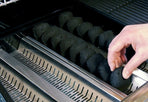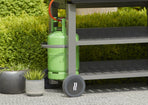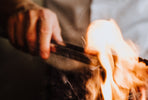Cooking with your Grillstream

One of the big problems a lot of people face when barbecuing is flare-ups. This is when fats and meat juices drop down onto the heat source and ignite. This can lead to burnt food on the outside and raw food on the inside.
The Grillstream system is different as it streams fat away from the heat source, basting the food as it goes, leading to perfectly cooked, succulent food – and a lot less stress when cooking!
How the Grills work
The simple science behind the double grill system is that the top grill streams away most of the fats and juices that would otherwise cause flare-ups. Anything that drips over the side of the top grill collects in the bottom grill.
This is why it’s important your grills are lined up correctly – they don’t need to be offset, so if you can’t see through the gaps you’ll need to readjust them so they line up. Both grills are slightly angled towards the front of your barbecue where the fat channel is located – this is why it’s important to ensure your barbecue is on flat, level ground.
Fat Channel and Cup
As the fats and meat juices stream towards the front of your barbecue they’re going to need somewhere to go. That’s where the fat channel comes in. This stainless steel channel is slightly angled towards the side of your barbecue to encourage the juices to flow this way.
Attached to the side of your barbecue should be the Fat Cup – this is where all of the fats and meat juices will collect. You should check this is empty before using the barbecue and it’s worth keeping an eye on how full it’s getting during cooking – you don’t want it to overflow!
Heating Up – Gas
It’s important to note that all Grillstream Grills and Griddles are made from Cast Iron which is porcelain coated to help prevent rust. As such they take a while to heat up – and trust us, you want them heated up!
Not only are the grills actually your main source of heat when cooking, if they’re not up to temperature before you put raw food on them you’re likely to find it sticking. To prevent this from happening simply light your gas burners and set them to a medium temperature (around halfway between Hi and Lo) for 15 minutes before starting to cook.
Heating Up – Charcoal
The same rules apply as with gas but, because you’re cooking with Charcoal, you’re more likely to need to light your barbecue 30 minutes before cooking. This will include the lighting time of the Charcoal (around 15 minutes) and then allowing time for the Charcoal to reach optimum temperature.
You’re looking for the Charcoal to be almost pure white before placing food on the grill, attempting to cook before this could result in prematurely burnt food.
Temperature Control - Gas
One of the key mistakes a lot of people make with barbecuing is thinking that, because there is a Hi setting, everything should be cooked at maximum heat.
Even if you might want a high temperature to get a good sear on a steak, depending on the cut of meat, you’ll still need to cook it at a lower temperature for the remaining time. It’s therefore wise to think about what it is you’ll be cooking, and the timings involved, before you put anything on the grill. Think about whether you’ll need Direct Cooking, Indirect Cooking or a mixture of the two.
Temperature Control - Hybrid
With the hybrid system it’s even more important to think about “zoning” your barbecue, as the ability to reduce temperature is not the same as when cooking with gas. One way to control this is by having part of your barbecue with Charcoal and part with gas, set at a lower temperature.
If things are cooking too fast on the Charcoal section you can quickly move them to the gas section, where they’ll continue to cook but at a more manageable rate. Likewise, you can cook something nice and slow on the gas first before moving to the Charcoal for that final sear – this works great when cooking chicken and you want to crisp up the skin!
Direct vs Indirect Cooking
Direct cooking is where the heat source is directly below whatever it is you’re cooking. his is perfect for small and medium sized items like Burgers, Sausages, Steaks, veggies etc. Simply set the burners (or charcoal) at the required temperature, place food above and turn as necessary.
Indirect cooking is best used when cooking larger items such as roasting joints or a whole chicken. The general rule of thumb is anything likely to take more than 20-30 minutes should be cooked using the indirect method.
To achieve this ensure the food item is placed centrally within the grill area, with the outer most burners used as the heat source and the hood kept closed, middle burners off.
Cooking in this way effectively turns your barbecue into a convection oven and ensures the larger item is cooked evenly throughout. Using this method you can really start to get experimental and cook things you might not expect you could do on a barbecue, such as cakes and bread!
You can also use the Indirect method with the Hybrid system. Follow the instructions above but load the two outermost Hybrid trays with Charcoal. Light as instructed in the previous section. Depending on expected cooking time you may need to top up the Charcoal – If you’re expecting to be topping up multiple times you may want to consider actually leaving the outer grills off to allow you to top up the Charcoal even more easily!
Hood up or down?
We know it can be tempting to keep the hood of your barbecue open the whole time you’re cooking, admiring your handy work and giving everything a reassuring prod!
Unfortunately this can actually have a negative impact on your cooking as, every time you lift the lid, you’re letting heat out (slowing cooking times and leading to potentially drier food) and you’re letting smoke out (and there’s some lovely flavour wrapped up in that smoke!).
With the Grillstream system taking care of any potential flare-ups, your food will need a lot less maintenance – simply turn your food once or twice and leave the hood down the rest of the time.
Cooking on a Side Burner
If your barbecue comes equipped with a Side Burner there are a whole range of possibilities to take advantage of. The Side Burner acts just like a gas hob, with all the instant controllability that comes with it. Warming up sauces in a pan is a great way of releasing some extra flavour. Or why not get a Cast Iron griddle pan up to temperature and cook your steak in it, getting those tell-tale sear lines in the process.
Cooking on the Steak Shelf
If your barbecue comes equipped with a Steak Shelf (Ceramic Side Burner) it can do everything a standard Side Burner can do… with an extra party trick up its sleeve! The Steak Shelf lives up to its name by having a stainless steel grill that you can cook food directly on – perfect for a nice bit of rib-eye.
The secret to the Steak Shelf is the fact it can get to over 600°C in a matter of minutes and cooks using Infrared. Any fats and juices that drop down onto it are vaporised and any that go down the side collect in its own driptray.
Featured Articles

January 05, 2024
Cooking with your Grillstream
One of the big problems a lot of people face when barbecuing is flare-ups. This is when fats and mea...

January 05, 2024
Charcoal for the hybrid system
We always recommend using Charcoal briquettes in the hybrid system as they provide a nice, long, eve...

January 05, 2024
Gas bottle safety
Gas safety is paramount when cooking on a Grillstream barbecue. Using the right gas, and ensuring th...

January 05, 2024
Fat fires
Fat fires and flare ups are a risk when barbecuing if the barbecue has not been maintained or is not...